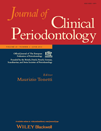Metabolic syndrome and periodontitis in Gullah African Americans with type 2 diabetes mellitus
Conflict of interest and source of funding statement
The authors declare that there are no conflicts of interest in this study. This study was supported by grants P20 RR-017696 (South Carolina COBRE for Oral Health) and M01 RR001070 from NCRR (National Center for Research Resources) and by grants R03DE020114-01A1 and R03DE021762-01 from NIDCR (National Institute of Dental and Craniofacial Research), which are parts of the US National Institutes of Health (NIH).
Abstract
Aim
To assess associations of metabolic syndrome, and its individual components, with extent of severe periodontitis among patients with type 2 diabetes mellitus (T2DM).
Materials & Methods
We performed a secondary data analysis (N = 283) using a cross-sectional study population of Gullah African Americans with T2DM. Extent of severe periodontitis was assessed as total diseased tooth-sites/person [evaluated as separate outcomes: 6+mm clinical attachment level (CAL), 5+mm periodontal probing depth (PPD)] using negative binomial regression techniques. Primary independent variables assessed in separate models included metabolic syndrome (yes/no), each metabolic syndrome component (low HDL, hypertension, high triglycerides, large waist circumference) and glycemic control (poor/good).
Results
Multivariable CAL-model results showed a significant association for metabolic syndrome status with extent of severe periodontitis (RR = 2.77, p = 0.03). The separate multivariable CAL-model including each metabolic syndrome component showed marginally increased rates among those with large waist circumference (RR = 2.33, p = 0.09) and those with HbA1c ≥ 7% (RR = 1.73, p = 0.06). Multivariable PPD-models showed marginally increased rates among those with metabolic syndrome (RR = 2.18, p = 0.06).
Conclusion
Metabolic syndrome is associated with the extent of severe periodontitis in this Gullah population with T2DM.




